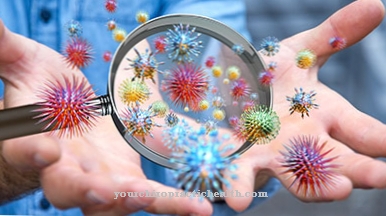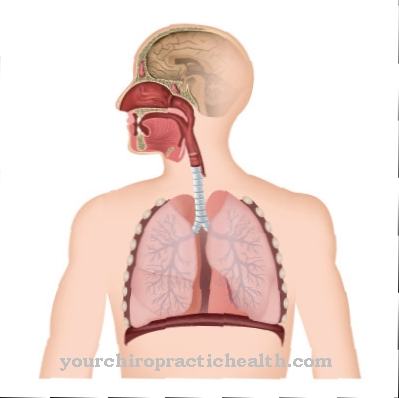A Hypospadias is an undesirable development in the urogenital tract. In affected boys, the urethra does not sit at the tip of the penis. This leads to various functional limitations that can be treated surgically.
What is hypospadias?

© alkov - stock.adobe.com
At a Hypospadias the urethral opening is on the underside of the penis and does not open at the tip of the penis. The urethra is shortened.
Depending on the severity, the urethra can then end below the glans or even at the perineum. As a result, it is difficult for the affected boy or the affected man to urinate while standing because the jet runs backwards. Hypospadias is one of the most common genetic malformations of the male urogenital tract. It is not infrequently associated with an enormous psychological burden on the parents and the affected boy.
A distinction is made between glandular, penile and scrotal hypospadias. The mildest form, glandular hypospadias, occurs most frequently. The urethral opening is on the underside of the glans. In penile hypospadias, the urethra opens into the penile shaft, which requires therapy and can lead to functional restrictions.
The most severe form is scrotal hypospadias, here the urethral opening is at the base of the penis or the perineum.
causes
The Hypospadias is a hereditary malformation. The formation of the urethra is usually over by the 14th week of pregnancy. However, development disorders or interruptions in development can occur up to this period. The severity of hypospadias depends on the developmental stage at which the disorder occurs.
In addition to the hereditary factor, endocrinological and environmental influences also play a role. A defect in the receptors for testosterone could be proven. If the mother takes the hormone progesterone during pregnancy, this can increase the baby's risk of developing hypospadias.
In addition, babies born underweight seem to have an above-average rate of hypospadias. However, the exact factors that lead to this clinical picture are not yet fully understood.
Symptoms, ailments & signs
A hypospadias can primarily be recognized by the shortened urethral opening. In boys, the urethral opening usually ends under the glans, in girls it ends in the vaginal wall. People with hypospadias have problems urinating and ejaculating. Urination and sexual intercourse can lead to pain and burning, which usually subsides after a few seconds to minutes.
Furthermore, the malformation manifests itself through repeated infections and inflammations in the affected area. Those affected are generally very limited in their everyday life and, in addition to the actual complaints, also suffer from avoidance behavior and the consequences that result from it. Regular urinary retention can cause inflammation and, in the worst case, lead to incontinence.
Avoiding sexual intercourse also results in emotional problems, among other things. Often those affected feel extremely uncomfortable with the disease and withdraw from social life. The often chronic complaints can cause psychological complaints in the patient and lead, for example, to inferiority complexes and depressive moods. For this reason, hypospadias must be diagnosed at an early stage and corrected as part of a surgical procedure.
Diagnosis & course
The treating urologist makes the basic diagnosis after a detailed physical examination.Then, in most cases, an ultrasound of the urethra is ordered. This also serves to clarify the severity, among other things.
If the ultrasound examination is noticeable, a urogram is then made. This is a contrast X-ray of the kidneys and urinary tract. In addition to these diagnostic measures, a micturition cystourethrography (MCU) can also be performed, during which the bladder is subjected to an X-ray examination before and after urination. As part of the diagnosis it is also important the severity of the Hypospadias to determine.
Basically, with the right therapy, the course of hypospadias is absolutely positive. In many cases, the undesirable development can be remedied both cosmetically and functionally through suitable measures.
Complications
The hypospadias causes complaints to the genital organs in the patient. In most cases, the patient will experience discomfort while ejaculating and urinating. This can lead to severe and burning pains that negatively affect everyday life. In addition, most men experience pain during intercourse.
This pain can often lead to psychological complaints, leading to inferiority complexes or reduced self-esteem. Depression and other psychological complaints can also occur. Hypospadias need not be treated in every case.
If the patient does not suffer from severe symptoms or feels restricted in his everyday life, treatment does not necessarily have to be carried out. In this case, there are no complications. Treatment is necessary if the hypospadias leads to pain or severe psychological complications.
This usually requires a surgical procedure. There are no particular complications with this procedure either. In rare cases, the interfaces can become inflamed after the operation and must therefore be treated with the help of antibiotics. Life expectancy is not affected by hypospadias.
When should you go to the doctor?
Hypospadias is usually diagnosed immediately after birth. Whether further visits to the doctor are necessary depends, among other things, on the severity of the malformation and any accompanying symptoms. A slight urethral opening can be closed immediately after birth and then only requires a few check-ups.
Larger malformations, which may be associated with problems urinating and ejaculating, require extensive medical treatment. Parents should take the child to the doctor if they complain of painful urination or show symptoms of fever. If the urethral opening becomes inflamed, further medical treatment is indicated. The affected person should be taken to a urologist immediately.
Early treatment lowers the risk of serious complications. That is why hypospadias should be clarified and treated as soon as possible, regardless of whether there are additional symptoms. Children of mothers who take the hormone progesterone during pregnancy are particularly likely to be born with hypospadias. That is why expectant mothers who regularly take medication should speak to their doctor regularly and have the child's health checked.
Doctors & therapists in your area
Treatment & Therapy
In mild cases of glandular Hypospadias Usually no therapeutic intervention is necessary. It is not uncommon for those affected with very mild forms of their hypospadias to be completely unaware.
However, if there are functional limitations, surgery is usually recommended. This ideally takes place from the first year of life of the affected boy. If the urethra is narrowed, an operation may be necessary even on babies. It is a complicated operation that can take several hours. The procedure always takes place under general anesthesia.
To correct hypospadias, there are various surgical approaches that depend on the severity of the malformation. The surgeons must also be aware of other malformations in the genitourinary tract that often occur with hypospadias. These include malformations of the erectile tissue in the penis or a penile shaft curvature.
It is not uncommon for there to be a split prepuce, which means that the foreskin is longer on one side and missing on the other side of the penis. During an operation, the urethra is placed on the tip of the penis. This should enable normal urination or a normal erection. The surgeons also try to straighten the penis.
prevention
Since it is a Hypospadias If it is a genetic or endocrinological abnormal development in the urogenital tract that occurs during early pregnancy, prevention is not possible.
Aftercare
After the hypospadias has been treated, small bruises and swelling may appear. However, these will heal after about four weeks. The operated children need regular check-ups. Most often, they stay in bed for two to three days and keep the bandage on for three to seven days. After carefully removing and clamping the abdominal wall catheter, the child is allowed to urinate normally again.
Depending on the treatment method, the healing process may take a little longer. Chamomile baths accelerate healing. The penis should be restored after four to six weeks at the latest. During the check-ups, the doctor makes sure of the patient's condition.
The children often feel slight pain immediately after the operation. When the penis has healed, a scar is left that runs in a ring under the glans and sometimes along the bottom. This shows the similarity to classical circumcision.
Home aftercare involves exercising some caution when walking and moving around. Often the children automatically take care not to move too violently. But parents can also take care that their offspring do not play sports too early. The one-week sick leave is an important support in this context.
You can do that yourself
If there is only a slight malformation in the area of the glans, hypospadias does not need to be treated in most cases. Nevertheless, pain can occur when urinating and in later life also during sexual intercourse, which, if the discomfort is mild, can be treated with light painkillers from the pharmacy.
Surgery may be necessary for more severe symptoms. After such an operation, those affected can promote recovery by observing appropriate hygiene measures and protecting the area where the operation took place for a few days. Activities that could stress the penis and the genital area in general should be avoided for the first time after the procedure.
Since an operation usually takes place in the first two years of life, parents must watch out for any abnormalities and contact the responsible doctor if there are signs of pain or similar symptoms. Further measures are limited to taking good care of the surgical scar in order to prevent the formation of a larger scar. The child should be informed as much as possible of the reasons for the procedure.



.jpg)









.jpg)

.jpg)
.jpg)











.jpg)